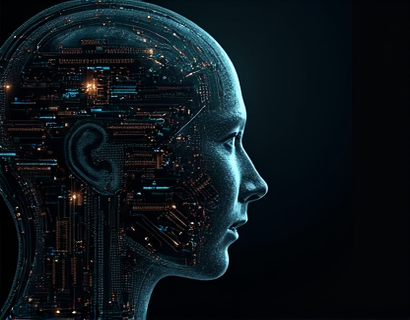Revolutionizing User Engagement: The Synergy of Crypto and AI in the Digital Age
The intersection of cryptocurrency and artificial intelligence (AI) is ushering in a new era of digital innovation, fundamentally transforming how users interact with apps and digital services. This fusion leverages the unique strengths of both technologies to create advanced solutions that enhance user experiences, drive growth, and foster meaningful connections in the rapidly evolving tech landscape. As tech-savvy individuals and professionals delve deeper into the realms of crypto and AI, understanding the latest advancements and their applications becomes crucial for staying ahead in this dynamic field.
Enhanced Security through Cryptographic Techniques
One of the primary ways crypto technology enhances user engagement is through robust security measures. Cryptographic techniques ensure that user data is protected against unauthorized access and breaches, building trust and confidence in digital platforms. Blockchain, the underlying technology of cryptocurrencies, provides a decentralized and immutable ledger that records transactions transparently and securely. This not only safeguards user information but also reduces the risk of fraud and cyber attacks, making digital interactions more secure and reliable.
Moreover, the use of cryptographic signatures and tokens can facilitate seamless authentication processes, streamlining user logins and transactions. For instance, decentralized identity solutions leverage blockchain to give users control over their personal data, allowing them to share information selectively and securely. This level of control empowers users, enhancing their overall experience and engagement with digital services.
Personalized User Experiences through AI
AI plays a pivotal role in creating personalized user experiences, a key factor in driving engagement and retention. Machine learning algorithms analyze vast amounts of user data to identify patterns and preferences, enabling apps to tailor content and recommendations to individual users. This personalization extends beyond simple suggestions, influencing everything from user interfaces to notification schedules, ensuring that each interaction is relevant and valuable.
For example, AI-driven chatbots powered by natural language processing (NLP) can provide instant, context-aware support to users, resolving queries and enhancing satisfaction. These chatbots learn from interactions, continuously improving their responses and adapting to user needs. By integrating AI into customer service, platforms can offer 24/7 support, reducing wait times and increasing user loyalty.
Predictive Analytics for Proactive Engagement
Predictive analytics, a subset of AI, allows platforms to anticipate user behavior and preferences, enabling proactive engagement strategies. By analyzing historical data and real-time interactions, AI models can forecast user actions, such as which features they are likely to use next or when they might churn. This foresight enables developers to implement timely interventions, such as personalized offers or targeted content, to keep users engaged and active on the platform.
In the context of cryptocurrency, predictive analytics can optimize trading strategies and portfolio management. AI algorithms can analyze market trends, news sentiment, and historical data to provide insights and recommendations, helping users make informed decisions. This not only enhances the user experience but also adds value by potentially increasing returns on investments.
Gamification and Incentivization through Crypto Tokens
Crypto tokens introduce a new dimension to gamification and incentivization, motivating users to participate actively and consistently. By integrating token-based reward systems, platforms can encourage desired behaviors, such as completing tasks, referring friends, or engaging with content. These tokens serve as a form of digital currency that users can earn, trade, or redeem for rewards, creating a sense of achievement and community.
For instance, a social media platform might use tokens to reward users for creating high-quality content or for engaging in meaningful discussions. This not only boosts user participation but also fosters a vibrant and interactive community. The use of blockchain ensures that the distribution of tokens is transparent and tamper-proof, adding another layer of trust and fairness to the system.
Decentralized Applications (DApps) for Enhanced Interactivity
Decentralized applications (DApps) represent a significant advancement in user engagement, leveraging both crypto and AI to create interactive and autonomous digital experiences. Unlike traditional apps, DApps operate on blockchain networks, offering greater transparency, security, and user control. AI enhances DApps by providing intelligent functionalities, such as automated decision-making and personalized user interfaces.
For example, a decentralized gaming platform can use AI to generate dynamic game environments and non-playable characters (NPCs) that adapt to player actions. This creates a more immersive and responsive gaming experience, keeping players engaged for longer periods. Additionally, the decentralized nature of DApps ensures that users have ownership over their in-game assets, which can be stored and traded using crypto tokens.
Enhanced Data Privacy through Blockchain and AI
Data privacy is a growing concern in the digital age, and the combination of blockchain and AI offers innovative solutions to protect user information. Blockchain's decentralized and encrypted nature ensures that data is stored securely and cannot be altered without consensus. AI, on the other hand, can be used to anonymize and aggregate data, preserving user privacy while still providing valuable insights.
Zero-knowledge proofs, a cryptographic method, allow users to verify the authenticity of their data without revealing the actual information. This ensures that platforms can confirm user identities or transactions without compromising privacy. AI algorithms can further enhance this by detecting and preventing unauthorized access attempts, creating a robust defense mechanism for user data.
Community-Driven Development and Feedback Loops
The synergy of crypto and AI fosters a community-driven approach to development, where users have a direct say in the evolution of digital services. Token-based governance models enable token holders to vote on proposals and contribute to decision-making processes, ensuring that the platform aligns with user needs and preferences. This democratization of development leads to more inclusive and user-centric solutions.
AI-powered feedback loops amplify this process by analyzing user interactions and sentiment in real-time. Platforms can use this data to identify areas for improvement and implement changes swiftly. For example, AI can monitor user feedback on a new feature and assess its impact on engagement, allowing developers to make data-driven adjustments to enhance the user experience.
Conclusion
The integration of cryptocurrency and AI is revolutionizing user engagement in the digital age, offering advanced solutions that enhance security, personalization, and interactivity. As these technologies continue to evolve, their applications will expand, driving growth and fostering deeper connections in the tech landscape. For those interested in crypto and AI, staying informed about these developments is essential for harnessing their potential and contributing to the next wave of digital innovation.











































